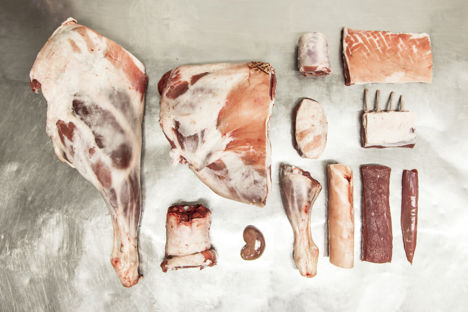Popular due to its soft pink flesh, lamb is one of the most consumed meats in the UK, as loved by chefs as it is by home cooks. Lamb can only technically be called lamb for the first year only of its life. In its second year you’re buying hogget, which is wonderful when roasted, while in its third year, the meat is categorised as mutton. Hogget and mutton are commonly eaten during the autumn and winter months due to their more gamy flavour; lamb is synonymous with spring and summer.
What to look for when buying lamb
Always buy lamb from a decent butcher and opt for British and organic if you can. Keep in mind that the meat of grass-fed animals contains more omega-3 fatty acids than grain-fed ones. If choosing a rare breed of lamb it may be darker and taste more gamy. When choosing lamb, look for a deep pink colour with a dry, white fat.
Lamb should be stored in the fridge and covered for up to a few days, or freeze. Offal or mince should be eaten on the day of purchase.
Common cuts of lamb for slow cooking include shoulder, leg, shanks, neck, breast, and chump. These cuts of meat have a higher fat content and are tougher. Slow cooking lamb should be in either liquid or basted to tenderize the meat. Slow cooking can take anywhere between 1-9 hours until the meat is falling off the bone. The length of time depends on the size of the cut and the temperature of the oven.
Slow cooking creates a more intense flavour due to the fat present in the cuts. The fat also helps to create tender meat.
Tender cuts of meat are more suited to quick cooking either by pan-frying or in the oven. A hot direct heat is necessary to cook the lamb quickly and served pink, overcooked lamb is dry and tough. Don’t forget if you’re roasting a joint, save those delectable juices to make gravy or jus. The cuts of lamb which are most suited to the rapid cooking are those that are less exercised such as lamb chops, rack of lamb, lamb cutlets, lamb noisettes, loin of lamb, leg of lamb and offal. Common offal cuts for lamb include kidneys, liver and sweetbreads. Offal is not to everyone’s taste, carrying a distinct smell and taste, but should be cooked quickly to retain tenderness and pinkness.
Paul Foster on lamb
What goes with lamb
Many cuisines have embraced lamb and therefore your options with the meat are plentiful. You could use lamb in a Moroccan style tagine, or, the Turkish way, using a soy-based marinade and served up with flatbreads. Indian chef Vineet Bhatia encrusts a rack of lamb with a mixture of fragrant spices – the wonderful, gamey flavour of lamb is often flattered by strong herbs and spices.
here are simpler ways to prepare lamb. Shepherd's pie is a traditional way to make the most of this phenomenal meat, while roast lamb with seasonal vegetables or lamb with Provençal vegetables are also classics. The traditional accompaniment to lamb is mint sauce - which is sharp enough to cut through the richness of lamb.
For a lamb dish with a difference, see this Robert Thompson recipe which uses lamb in a carpaccio with shallot mousse, pickled walnuts and quails eggs.
Get in touch
Please sign in or register to send a comment to Great British Chefs.


